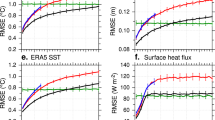Abstract
One conceptual model of weather is that of a series of events which are unconnected. That is, that the weather next week is essentially independent of the weather this week. However, although individual weather systems might be chaotic and unpredictable beyond a week or so, the statistics describing them may be perturbed in a deterministic and predictable way1, particularly by the ocean. In the past, seasonal forceasts of atmospheric variables have largely been based on empirical relationships, which are weak in most areas of the world2. More recently, atmosphere models forced by assumed or predicted ocean conditions have been used3,4. Here a fully coupled global ocean–atmosphere general circulation model is used to make seasonal forecasts of the climate system with a lead time of up to 6 months. Such a model should be able to simulate the predictable perturbations of seasonal climate, but to extract these from the chaotic weather requires an ensemble of model integrations, and hence considerable computer resources. Reliable verification of probabilistic forecasts is difficult, but the results obtained so far, when compared to observations, are encouraging for the prospects for seasonal forecasting. Rainfall predictions for 1997 and the first half of 1998 show a marked increase in the spatial extent of statistically significant anomalies during the present El Niño, and include strong signals over Europe.
This is a preview of subscription content, access via your institution
Access options
Subscribe to this journal
Receive 51 print issues and online access
$199.00 per year
only $3.90 per issue
Buy this article
- Purchase on Springer Link
- Instant access to full article PDF
Prices may be subject to local taxes which are calculated during checkout



Similar content being viewed by others
References
Palmer, T. N. Extended range atmospheric prediction and the Lorenz model. Bull. Am. Meteorol. Soc. 74, 49–65 (1993).
Barnston, A. G. Linear statistical short-term climate predictive skill in the northern hemisphere. J. Clim. 7, 1513–1564 (1994).
Barnett, T. P. et al. Forecasting global ENSO-related climate anomalies. Tellus A 46, 367–380 (1994).
Livezey, R. E., Masutani, M. & Ji, M. SST-forced seasonal simulation and prediction skill for versions of the NCEP/MRF model. Bull. Am. Meteorol. Soc. 77, 507–517 (1996).
Ji, M., Leetmaa, A. & Kousky, V. E. Coupled model predictions of ENSO during the 1980s and the 1990s at the National Centers for Environmental Prediction. J. Clim. 9, 3105–3120 (1996).
Palmer, T. N. & Anderson, D. L. T. The prospects for seasonal forecasting: a review. Q. J. R. Meteorol. Soc. 120, 755–793 (1995).
Hastenrath, S. Recent advances in tropical climate prediction. J. Clim. 8, 1519–1532 (1995).
Livezey, R. E. et al. Teleconnective response of the Pacific-North American region atmosphere to large central Pacific SST anomalies. J. Clim. 10, 1787–1820 (1997).
Reynolds, R. W. & Smith, T. M. Improved global sea surface temperature analyses using optimum interpolation. J. Clim. 7, 929–948 (1994).
Smith, N., Blomley, J. E. & Meyers, G. Aunivariate statistical interpolation scheme for subsurface thermal analyses in the tropical oceans. Prog. Oceanogr. 28, 219–256 (1991).
Stockdale, T. N. Coupled ocean-atmosphere forecasts in the presence of climate drift. Mon. Weath. Rev. 125, 809–818 (1997).
Blanke, B., Neelin, J. D. & Gutzler, D. Estimating the effect of stochastic wind stress forcing on ENSO irregularity. J. Clim. 10, 1473–1486 (1997).
Eckert, C. & Latif, M. Predictability of a stochastically forced hybrid coupled model of El Niño. J. Clim. 10, 1488–1504 (1997).
Kleeman, R. & Moore, A. M. Atheory for the limitationof ENSO predictability due to stochastic atmospheric transients. J. Atmos. Sci. 54, 753–767 (1997).
Stockdale, T., Latif, M., Burgers, G. & Wolff, J.-O. Some sensitivities of a coupled ocean-atmosphere GCM. Tellus A 46, 367–380 (1994).
Wonnacott, T. H. & Wonnacott, R. J. Introductory Statistics(Wiley, New York, (1977)).
Fraedrich, K. An ENSO impact on Europe? A review. Tellus A 46, 541–552 (1994).
Acknowledgements
The model integrations were carried out on a VPP300 machine donated by Fujitsu Limited. The ocean model was provided by the Max-Planck-Institut für Meteorologie, Hamburg; ocean data assimilation software by the Bureau of Meteorology Research Centre, Melbourne; and coupling software by CERFACS, Toulouse.
Author information
Authors and Affiliations
Corresponding author
Rights and permissions
About this article
Cite this article
Stockdale, T., Anderson, D., Alves, J. et al. Global seasonal rainfall forecasts using a coupled ocean–atmosphere model. Nature 392, 370–373 (1998). https://doi.org/10.1038/32861
Received:
Accepted:
Issue Date:
DOI: https://doi.org/10.1038/32861
This article is cited by
-
Seasonal forecast skill of upper-ocean heat content in coupled high-resolution systems
Climate Dynamics (2022)
-
A theoretical relationship between probabilistic relative operating characteristic skill and deterministic correlation skill in dynamical seasonal climate prediction
Climate Dynamics (2021)
-
Tropical rainfall subseasonal-to-seasonal predictability types
npj Climate and Atmospheric Science (2020)
-
Quantifying horizontal length scales for surface wind variability in the tropical Pacific based on reanalyses
Climate Dynamics (2020)
-
On the use of Markov chain models for drought class transition analysis while considering spatial effects
Natural Hazards (2020)
Comments
By submitting a comment you agree to abide by our Terms and Community Guidelines. If you find something abusive or that does not comply with our terms or guidelines please flag it as inappropriate.



